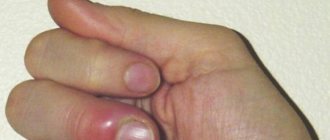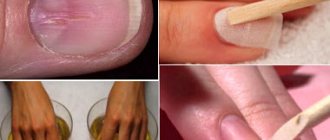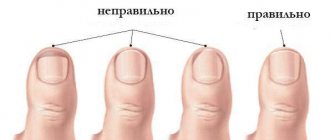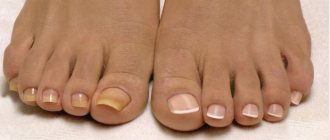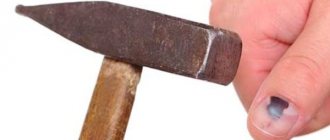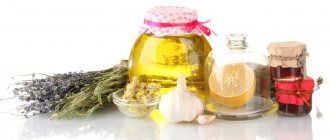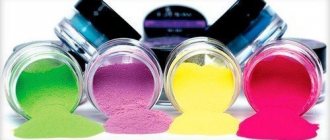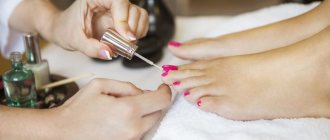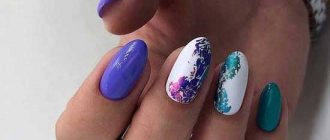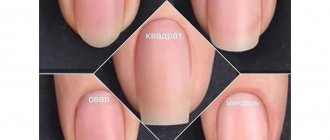Change in nail color due to fungal infection
Among all the diseases that occur with changes in nail color, onychomycosis is the most common. With these diseases, color changes, shine is lost, stripes and spots appear, and the thickness of the nail plates increases. Over time, they become deformed, crumble, collapse, or become detached from the nail bed.
More often than not, nail plates with fungal infections become yellowish or brown in color. With trichophytosis - dirty gray. With rubromycosis and favus - yellow coloration.
Rice. 1. The photo shows onychomycosis (normotrophic type). The nail plate retains its configuration for a long time. In its depth, spots and stripes of white or deep yellow color are visible. Over time, the discolored areas merge.
Rice. 2. The photo shows a nail disease caused by the fungus Trichophyton rubrum (onycholytic type). The nail plate quickly loses its original color and becomes dull, acquiring a whitish or whitish-yellowish color. There is a rapid separation of the nail plate from the nail bed from the side of the free edge.
Rice. 3. The photo shows onychomycosis (hypertrophic type). This form of the disease is the most common. Up to 90% of cases are caused by fungi of the genus Trichophyton rubrum. The development of subungual hyperkeratosis entails a significant thickening of the nail, which over time loses substance, causing the surface to become “eaten away.” In its thickness, whitish spots and stripes of white and yellow are visible.
Rice. 4. The photo shows white superficial onychomycosis. The second most common form of onychomycosis. In 90% of cases, the disease is caused by a fungus of the genus Trichophyton interdigitale, which affects only the top layer of the nail plate, which never thickens or separates from the skin. Over time, its entire surface becomes loose, like chalk powder.
Diagnostics
The appearance of discoloration of the thumbnails should make everyone consult a dermatologist. He will take an anamnesis, scrape the affected area and, using microscopy, try to find out what caused the unsightly cosmetic defect. Only then will he be able to formulate an effective treatment.
Change in nail color due to psoriasis
The causes of psoriasis have not yet been established. The disease is considered multifactorial. There is no doubt that changes in the immune system play a large role in the development of the disease. Nail plates with psoriasis change long before the appearance of the main manifestations of the disease - psoriatic plaques on the skin. The more the matrix is involved in the pathological process, the more pronounced the change in the nail plate, which over time completely loses its structure and color.
Rice. 5. The photo shows nail disease due to psoriasis. A characteristic sign of primary psoriasis is a narrow reddish-pinkish strip visible through the nail plate.
Rice. 6. The photo shows nail disease due to psoriasis. Under the nail plate, a reddish or salmon-colored coloration is visible, resembling a drop of oil in shape.
Rice. 7. The photo shows an erythematous-spotted form of psoriasis. Yellowish spots appear through the nail plate.
Rice. 8. The photo shows nail disease due to psoriasis. The structure of the nail plate on the matrix side is destroyed, the undamaged part has acquired a smoky color.
Treatment methods
There are different therapeutic regimens to treat black spots on the toes. They are selected taking into account the cause of the disease.
Injury
If there has been trauma, complete removal of the plate is indicated. A hematoma can cause fluid to accumulate under the nail. It often causes purulent inflammation. A puncture or resection will help get rid of it. For treatment, you need to contact a traumatologist.
Sometimes timely first aid can prevent the occurrence of unwanted complications. If you wash your foot well immediately after an injury, dry it, and apply a cold compress to the nail, you may be able to avoid bruising. To reduce inflammation, it is useful to lubricate the sore spot with Heparin ointment in the first three days; it is important to bandage the injured nail and try not to touch it. To eliminate additional stress, experts recommend changing shoes to looser ones, in which the sore leg will feel more comfortable.
Even if the injury has caused the plate to move, you should not try to tear it off yourself. A product called Nogtivit will help speed up the process of its rejection. It is sold in pharmacies in two forms: as a patch and an emulsion. The first one is easier to use. Using the drug allows you to easily remove an injured nail at home.
Note! If a plate injury causes severe inflammation and severe pain that constantly intensifies, you cannot self-medicate. It will provoke a deterioration in overall health and lead to the development of dangerous complications.
Fungus
Detection of a fungal nature requires the prescription of systemic and local antimycotic agents. Diflucan, Mycomax, Irunin, and Lamisil are prescribed for oral administration. The choice of drug is made on the basis of deciphering laboratory tests that allow identifying the causative agent of the infection. To treat nails, use Ciclopirox varnish, Exoderil cream or solution.
The therapy is long-term: local treatment is carried out until the new nail grows completely. Recovery directly depends on how strictly the patient adheres to the proposed recommendations.
Diseases of internal organs
If damage to the nail plates occurs as a result of an internal disease, you need to visit your doctor and, together with him, draw up a treatment plan for the nail damage. Without eliminating the causes of the described cosmetic defect, any local therapy will be ineffective.
Dyes
Nails that have darkened after contact with coloring compounds can be whitened using folk remedies. Best suited for these purposes:
- Regular baking soda. Using powder and water, prepare a creamy mixture, apply it to washed nails and wait until completely dry. Afterwards, rinse and lubricate the plate with any vegetable oil.
- Hydrogen peroxide. Mix peroxide and glycerin in proportions 1:5, apply to the darkened nail and cover with a cotton swab. After ten minutes, rinse and lubricate with any nourishing cream.
It may be necessary to carry out several whitening procedures to achieve the desired result.
Nail diseases in which the nail plates have white spots (leukonychia)
Leukonychia is the coloring of the nail plates white - from dotted and stripe-like to total.
The most common type is punctate leukonychia . It is caused by injuries during manicure. Leukonychia punctata occurs as a result of exposure to certain chemicals. Often the cause of punctate leukonychia cannot be identified.
Leukonychia punctata may transform into leukonychia stripe . It is assumed that this type of change in nail color is associated with changes in trophic nature. White stripes on the nails appear due to arsenic and thallium poisoning.
Total white coloring of nails (white nails or Terry nails) appears in 80% of cases in patients with cirrhosis of the liver. They are a symptom of kidney and heart failure, diabetes, iron deficiency anemia and malnutrition. White discoloration of the nail bed is seen with chemotherapy and excessive production of thyroid hormones. Scientists believe that Terry's nails appear when the number of blood vessels decreases and connective tissue grows in the nail bed. At the same time, the nails become matte. White nail plates are often found with onychomycosis.
Rice. 9. The photo shows white spots on the nails (punctate leukonychia).
Rice. 10. The photo shows white spots on the nails (streak-like leukonychia).
Rice. 11. The photo shows white superficial onychomycosis. In 90% of cases, the disease is caused by a fungus of the genus Trichophyton interdigitale, which affects only the top layer of the nail plate, which becomes loose, like chalk powder.
Rice. 12. The photo shows white “Terry’s nails.” Total white staining appears in 80% of cases in patients with liver cirrhosis.
Rice. 13. The photo shows psoriasis. The nail plate is destroyed and has a grayish-white color.
Rice. 14. The photo shows arched lines on the nail plates (Murke lines). Occurs in patients with a reduced amount of protein in the blood. When the protein amount is normalized, the lines disappear.
Causes of black spots on the nail plate
Various reasons can provoke the appearance of black spots on the nail plates. To determine what exactly caused the formation of such a symptom, it is necessary to pay attention to additional manifestations.
Hematoma under the nail
The following table helps you navigate this issue.
| Name of pathology | Etiology | Pathogenesis | Diagnostic signs |
| Fungal infection | Infection is caused by various yeast-like microorganisms. Some of them are part of the opportunistic human microflora. With a sharp decrease in immunity, they are activated. You can become infected with others by visiting pedicure salons, putting someone else’s shoes on your feet, or using someone else’s hygiene products. | With a fungal infection, the nail plate gradually changes its color. At first it becomes cloudy, yellow, gray or brown. Blackness occurs in rare cases when the infection penetrates deeply and affects the nail bed. | The nail grows, but the area of the healthy plate below does not appear. It has an unnatural color for two to three months |
| Injury | The big toe is injured more often than other toes. This happens both with a direct blow and when wearing tight shoes. In the latter case, the color of the plate changes due to constant compression of the blood vessels supplying the nail. They burst and a hematoma forms. If you change your shoes, after two weeks the blackness will begin to lighten and change its hue to purple with a red tint | When injured, the nail hurts, the tissues surrounding it swell and become red. | The color of the hematoma changes, becomes lighter, and a new nail grows from below |
| Hemangioma | A benign tumor begins to grow under the nail plate, enveloped in a network of blood vessels. | Looks like darkening. The formation of a benign tumor does not cause pain to a person, it does not interfere with his walking, and its presence does not require the selection of special shoes. Hemangioma can disappear on its own without treatment, but this takes many years | The nail is not black, but red-brown in color |
| Dyes | Nails can change their color while staining with iodine or after taking a course of baths with potassium permanganate. In women, a common cause of darkening of the nail plates on the big toes is the use of low-quality varnishes. Men experience increased sweating. Nail staining can also occur while wearing faded socks or shoes. | The nail darkens, it is not possible to remove the defect with solvents: the aggressive dye is able to penetrate into the deepest layers of the nail tissue, so to eliminate the defect you have to wait until the nail grows back completely | Eliminating the cause allows you to achieve recovery without the use of specialized therapy |
| Diabetes | In its advanced form, this disease leads to destabilization of metabolic processes. As a result, blood vessels suffer and blood circulation is impaired. | Black spots often appear on the big toes, and the plates themselves become severely delaminate and crumble. A person suffering from diabetes sweats profusely. His legs are often and seriously injured, all this together creates favorable conditions for the proliferation of pathogenic microorganisms. That is why, with the disease described, abscesses develop, which can result in gangrene and amputation of the fingers. | Frequent urination, constant feeling of thirst, weight loss with good appetite, constant presence of weakness and fatigue, fatigue |
| Cardiovascular diseases | The thumbnail is dark blue rather than black. | Chest pain, shortness of breath, fatigue, rapid heartbeat, dizziness |
Fungal infection of the nail plate
Problems with blood circulation in the legs, diseases of the brain, central nervous system, and oncology can provoke the appearance of black spots (black spots appear on the plates, and over time their number may increase). That is why you cannot deal with the problem described on your own. There are other pathological changes that should attract attention.
Black stripes on nails
Barely noticeable dark stripes located transversely to the nail plate indicate a lack of vitamins or the development of diseases of the gastrointestinal tract. Often this defect manifests itself in women who sit for a long time on strict restrictive diets. Doctors, when faced with such patients, recommend that they switch to a balanced diet, enrich it with vitamins, beneficial microelements, and fatty acids. The stains should disappear after this.
If this does not happen, if the black spot on the big toe nail is constantly increasing in size, it is necessary to undergo a full examination: subungual melanoma may be developing.
Brown spot on big toe nail
This symptom indicates that a person is not eating properly. It appears when there is a lack of protein and folic acid. The phenomenon provokes the release of black pigment, which accumulates in the capillaries that provide nutrition to the nail plates. Women often face this type of problem during pregnancy. Doctors advise not to worry about this. The developing fetus takes a large amount of nutrients from the mother’s body. As soon as the body adapts to the new operating conditions, everything will work out, the brown spots on the toes will disappear on their own.
There is a dark spot under the extended nail
The appearance of such a defect after a cosmetic procedure means one thing - it was carried out incorrectly, in violation of technological processes. Perhaps the specialist used unsterile instruments during his work or violated hygiene rules. The artificial material used in the extension process does not fit tightly onto the plate. A microscopic air layer forms between them. A fungus can settle inside it. There it feels very good, actively reproduces and infects free space.
There are signs that directly indicate the development of infection:
- redness of the affected area;
- severe pain that appears when you press the plate;
- blackness that appears when removing varnish.
If such manifestations are detected, you must immediately contact a more experienced pedicurist, get rid of the varnish, remove the extension and make an appointment with a dermatologist. He will be able to identify the causative agent of the infection and prescribe adequate treatment.
Nail diseases in which the nail plates are yellow (“yellow” nails)
A yellow color appears with a fungal infection, when the cause of the disease is red trichophyton and some types of mold fungi aspergillus.
Yellow coloration is observed in bronchiectasis, sinusitis, thyroid diseases and tuberculosis. It is often a sign of jaundice.
The nail plates turn yellow when taking the antiparasitic drug quinine and carotene. When using resorcinol, a yellow-orange color is observed.
The yellow color of the nail plate becomes due to frequent use of low-quality varnish.
With defects in the development of the lymphatic system, the nails slow down their growth, thicken, lose transparency, become yellow, and the lunula disappears. The disease is accompanied by swelling of the upper limb and periungual fold.
Rice. 15. The photo shows yellow nail plates due to fungal infection.
Rice. 16. In the photo, yellow nail plates are one of the syndromes associated with a number of diseases.
Nail diseases in which the nail plates are brown (“brown” nails)
Brown staining of the nail plates is most often observed with onychomycosis caused by trichophyton red, chronic renal failure (in 40% of cases) and Addison's disease.
Nails acquire a brownish color in women during pregnancy, surgical interventions for diseases of the female genital organs, diabetes, malnutrition, thyroid disease, frequent use of low-quality varnish, use of certain medications (gold preparations, zidovudine, anthracyclines, etc.) .
Nail plates acquire a brownish-green tint due to candidiasis and aspergillosis.
Rice. 17. In the photo there is a nail disease - onychomycosis.
The toenail turned black. reasons, photos, treatment, which doctor to see - your doctor
Blackening of the big toe nail is a fairly common problem that every second person has encountered.
As a rule, it causes aesthetic inconvenience, forcing a person to look for various ways to hide and disguise an unattractive defect.
This circumstance makes treatment difficult: the vast majority do not attach any importance to the disease, preferring to ignore it, hide it under cosmetic varnish or closed shoes.
However, blackness under the nail on the big toe often acts as a harbinger of serious diseases, signaling internal failures and disorders occurring in the body. That is why, if you discover a suspicious darkening, do not be lazy to make an appointment with a podiatrist.
After conducting a series of diagnostic measures, he will determine an accurate diagnosis and draw up an effective recovery program.
Causes
Recent research in the field of podology has made it possible to identify a whole range of reasons that can provoke darkening of the nail plate.
Conventionally, they can be divided into two large groups: those that are internal in nature, and those that are caused by external factors. We will talk in more detail about the nature of the development of the disease below.
Domestic
How to understand that the nail on the thumb has turned black due to failures and disorders occurring in the body? Without prior consultation with a specialist and passing certain tests - no way. If you want to identify the true cause of the disease, do not delay going to the doctor, because only he can create a competent and effective treatment program.
A darkened toenail may be due to the following:
- Fungus is one of the most common causes of blackening. During the life of fungal spores, the nail plate acquires a rich blue-violet hue, which begins to rapidly darken. The medical name of the disease is melanonychia. The risk group is represented by people suffering from autoimmune disorders, weakened immunity, and various hormonal imbalances. The disease often affects pregnant women, as well as adolescents during puberty.
- A benign tumor is another reason why the nail on the big toe has darkened. Pathological processes provoke the proliferation of blood vessels, which leads to a gradual change in the color of the plate.
- Excessive sweating is perhaps one of the most unobvious factors. Overactive sweat glands create an atmosphere around the finger that is favorable for the proliferation of pathogenic bacteria. They cause the nail on the big toe to turn black.
- Vascular pathologies, in particular failures of venous outflow. Problems with circulation cause hemorrhage in the area of the nail plate and, as a result, the formation of non-aesthetic blackness.
- Diabetes. People suffering from this disease are most vulnerable and are prone to blackening and darkening.
- Avitaminosis. A lack of vitamins and beneficial microelements negatively affects the health of the nail plates, leading to a change in color, the appearance of dark spots and other imperfections.
Along with the listed factors, so-called systemic diseases are also distinguished. These include: disorders of the cardiovascular system, renal and liver failure, endocrine pathologies.
External
Most often, the toenails of the big toe darken due to quite obvious and manageable reasons. Having a transient nature and not associated with internal failures, they are easily eliminated and do not cause serious consequences.
As a rule, treatment in this case is limited to the banal elimination of the irritating factor and does not involve specific therapeutic measures. What could provoke the circumstances under which the nails on the big toes would turn black?
- Mechanical damage or injury. The change in color of the marigold to black, brownish or dark gray occurs due to hemorrhage and does not cause harm to health. As a rule, the plate returns to its normal state after two to three weeks.
- Wearing uncomfortable shoes. This reason is especially relevant for women who spend a lot of time in narrow high-heeled shoes.
- External painting. If the toenail turns black, but does not hurt, the reasons for such metamorphosis should be sought in external factors. For example, new shoes impregnated with paints and pigments can provoke a chemical reaction on the surface of the plate, which will lead to a color change. To be fair, we note that this happens extremely rarely.
How can you tell if your toenails have turned black due to injury? Igor Demyanov, a certified specialist in the field of podology, answers this question: “Identifying this cause is not difficult. If you notice a slight blue discoloration on the plate, and only then part of the toenail has darkened, the diagnosis is strictly defined: blackening due to mechanical damage.”
Is blackening dangerous?
There is a stereotype in society that a blackened nail plate is an exclusively cosmetic defect that does not require specialized treatment. In reality, everything is somewhat different.
So, for example, if a toenail turns brown due to wearing uncomfortable shoes or using low-quality varnishes, there is really no reason to worry. However, if blackness rapidly spreads across the plate, accompanied by discomfort or pain, you should immediately consult a doctor to determine an accurate diagnosis.
Thus, blackening is dangerous if ignored. Timely contact with a specialist, compliance with all appointments and instructions helps to avoid any consequences.
Why is there no pain?
Blackening is not always accompanied by painful sensations. The problem can occur quite unnoticed, without causing any particular inconvenience to its owner. However, behind the external harmlessness and frivolity, pathologies that can cause damage to health are often hidden.
The nail on my toe has darkened, why is there no pain:
- development of the fungus at the initial stage;
- malfunctions of internal organs;
- specific manifestation of an allergic reaction.
Despite the absence of pain, the problem still needs to be solved.
Features of treatment
The effectiveness of therapeutic measures depends on the correct selection of the means used. So, for example, if the toenail has darkened due to a fungal infection, it is foolish to smear the affected areas with an antihistamine or healing ointment.
More radical methods of restoration are required. Next, we present to your attention the most effective treatment methods depending on the cause of the disease.
In case of injury
Mechanical damage is the most common reason why the toenail darkens. It is also considered the most amenable to treatment, responding positively to the methods of influence used.
The first step that needs to be taken to get rid of blackness is to eliminate the irritating external factor. In other words, you need to change uncomfortable shoes, stop wearing high heels, etc. Subsequent measures are determined by the specifics of the injury.
Small hematomas do not require outside intervention and resolve on their own. Larger ones are treated with healing compresses and bandages.
If there are internal violations
It is almost impossible to independently detect malfunctions occurring in the body; consultation with a doctor is required. He also compiles a list of drugs to get rid of the disease. As a rule, if the nail turns black and hurts on the leg, blood thinners are prescribed that normalize the functioning of the internal systems (cardiovascular, endocrine, renal and hepatic).
6 secret ways to keep your nails beautiful and healthy
A dark toenail is an unpleasant ailment that requires long-term and complex treatment. If you don’t want to burden yourself with this, you should already take care of the quality and health of the plates. After all, as you know, a disease is much easier to prevent than to cure.
Below we offer a selection of the most effective and efficient preventive measures that ensure the beauty and health of your nails:
- Wear shoes that do not restrict movement.
- When visiting places with high humidity, choose rubberized slippers with high soles.
- Organize regular cleaning using disinfectants.
- Take care of shoe hygiene - you need to treat the inner surface at least once every one to two weeks.
- Do not overuse wearing someone else’s shoes or sandals (this is important when visiting).
- Choose a multivitamin complex that will help maintain normal hair and nails.
By following these recommendations, avoid unattractive blackness!
Why women's toenails turn black and how to treat them
The phenomenon of blackening of the nail plate occurs in both sexes. The symptoms are not accompanied by pain, as a result of which people simply do not pay attention to this problem. Most often, the big toe turns black, which is directly related to the causes of the phenomenon. Women have found a way out: they simply paint their nails with varnish, which hides all defects.
But if a problem arises, you should understand that a blackened nail may indicate the presence of a serious disease. If you find that your leg or arm has turned black for no apparent reason, you should immediately contact a dermatologist. Why darkening occurs, as well as the features of treatment of resulting diseases, we will find out in more detail.
Why do toenails turn black: reasons
Initially, it should be noted that a black toenail is not a reason to despair. After all, such a phenomenon does not always indicate the presence of serious diseases.
To refute the presence of dangerous pathologies, you need to visit a doctor who will determine the cause and make a diagnosis.
It is also important to understand that the sooner you see a doctor, the more effective the treatment and recovery process will be.
Nail diseases in which the nail plates are green (“green” nails)
Nails acquire a black-green color when Pseudomonas aeruginosa develops in the loose structure of the nail. White, brown, green or black color is given to the nail plates by fungi of the genus Aspergillus. The disease most often affects the nails of the first three toes. Whitish spots or stripes are visible on their surface. Over time, the surface itself becomes soft, powdery and crumbly, grayish, brownish or green in color.
Rice. 18. The photo shows a nail disease caused by mold fungi of the genus Aspergillus.
Rice. 19. The photo shows a nail disease caused by fungi of the genus Candida albicans. The fungus colonizes weakened areas. More often, the nail plates on the hands are affected, which become discolored or acquire a brownish or greenish color and thicken. Sometimes the surrounding skin is affected, which causes pain. Wearing artificial nails contributes to the disease.
Rice. 20. The photo shows a nail disease caused by Pseudomonas aeruginosa (onychia pseudomonas). Pseudomonas aeruginosa colonizes in the cavities of the nail plates.
Nail diseases in which the nail plates have a gray-blue or blue color (“blue” nails)
When broad-spectrum antibiotics tetracycline and minomycin are used, the nails turn blue; when trichophytosis occurs, they turn dirty gray.
The nail plates acquire a gray-blue color when taking the antimalarial drug quinine and the antiprotozoal drug chloroquine.
The color changes with an increase in methemoglobin in the blood. In some cases, methemoglobinemia develops during acute poisoning with aniline dyes, paracetamol, potassium permanganate, etc. and chronic intoxication with silver compounds (argyria). There is congenital methemoglobinemia.
Rice. 21. The photo shows nail plates that have a gray-blue color.
Rice. 22. The photo shows a nail disease caused by taking Minocycline.
Rice. 23. The photo shows Wilson-Konovalov disease, in which an excess of copper in the body leads to its accumulation in many organs, including nails and the cornea of the eye.
Rice. 24. The photo shows a bluish coloration of all nail plates due to insufficient peripheral circulation (hypoxemia), which is most often caused by chronic heart failure. A bluish discoloration of the peripheral parts of the body is observed on the hands, tip of the nose, lips and ears.
